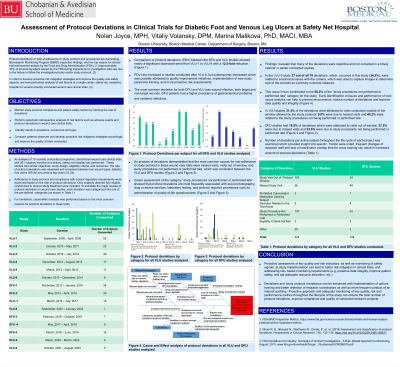Clinical Research
(CR-017) Assessment of Protocol Deviations in Clinical Trials for Diabetic Foot and Venous Leg Ulcers at Tertiary Care Safety Net Hospital.

Methods:
Analysis included 15 clinical trials with 261 participants enrolled for DFUs and VLUs indications and compared rates and types of deviations. All protocols were rated according to established complexity scoring model. (7) Statistical analyses examined associations between protocol complexity, type of study product, phase of clinical trial versus number and type of protocol deviations. Study personnel changes/experience were assessed in correlation with protocol deviations.
Results: The results of our analysis showed number of deviations (325) in VLU trials as compared to DFUs (128). VLUs and DFUs had rates of deviations of 1.9 and 1.4 per each enrolled subject, respectively. In examining association a trend was observed towards increased number of deviations once more subjects have entered the study. The highest number of deviations in both indications occurred due procedures not performed or done late. Assessment of complexity score in Pearson’s correlation test with the number of protocol deviations showed weak correlation, suggesting that other factors can influence protocol adherence. There was no correlation observed between number of deviations and type of study product utilized in the study
Discussion: Analyzing trends in protocol compliance leads to strategies to better conduct of trials. Increased deviations related to missed procedures could complicate wound healing. Different factors may effect deviations based on therapeutic indication, including co-morbidities of participants or study coordinator experience. Proactive, risk-based monitoring of protocol adherence can lead to quality improvement and mitigate issues with data integrity.
Trademarked Items:
References: 1. Chan, B., Cadarette, S., Wodchis, W., Wong, J., Mittmann, N., & Krahn, M. (2017). Cost-of-illness studies in chronic ulcers: a systematic review. Journal of wound care, 26(sup4), S4–S14. https://doi.org/10.12968/jowc.2017.26.Sup4.S4
2. Leg Ulcers Clinical Trials.Gov. Clinical Trials. Retrieved June 9, 2023, from https://clinicaltrials.gov/ct2/results?cond=leg+ulcers&term=&cntry=&state=&city=&dist=
3. Milic, D. J., Zivic, S. S., Bogdanovic, D. C., Karanovic, N. D., & Golubovic, Z. V. (2009). Risk factors related to the failure of venous leg ulcers to heal with compression treatment. Journal of vascular surgery, 49(5), 1242–1247. https://doi.org/10.1016/j.jvs.2008.11.069
4. Ghooi, R. B., Bhosale, N., Wadhwani, R., Divate, P., & Divate, U. (2016). Assessment and classification of protocol deviations. Perspectives in clinical research, 7(3), 132–136. https://doi.org/10.4103/2229-3485.184817
5. Getz, K., Smith, Z., Jain, A., & Krauss, R. (2022). Benchmarking Protocol Deviations and Their Variation by Major Disease Categories. Therapeutic innovation & regulatory science, 56(4), 632–636. https://doi.org/10.1007/s43441-022-00401-4
6. Malikova M. A. (2017) Building Quality Assurance (QA) and Risk-Based Quality Management (RBQM) Systems into Clinical Research Operations. An Academic Site Perspective. Journal of Clinical Trials and Regulatory Affairs. 1(1):1-8.
7. Malikova M. A. (2016). Optimization of protocol design: a path to efficient, lower cost clinical trial execution. Future science OA, 2(1), FSO89. https://doi.org/10.4155/fso.15.89

.png)